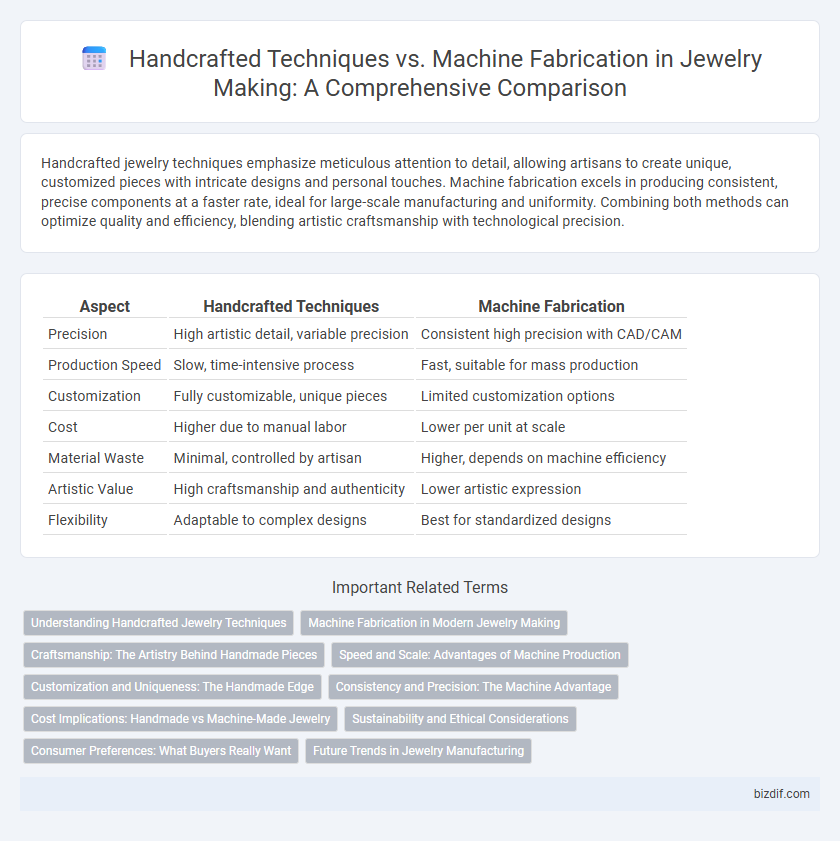Handcrafted jewelry techniques emphasize meticulous attention to detail, allowing artisans to create unique, customized pieces with intricate designs and personal touches. Machine fabrication excels in producing consistent, precise components at a faster rate, ideal for large-scale manufacturing and uniformity. Combining both methods can optimize quality and efficiency, blending artistic craftsmanship with technological precision.
Table of Comparison
| Aspect | Handcrafted Techniques | Machine Fabrication |
|---|---|---|
| Precision | High artistic detail, variable precision | Consistent high precision with CAD/CAM |
| Production Speed | Slow, time-intensive process | Fast, suitable for mass production |
| Customization | Fully customizable, unique pieces | Limited customization options |
| Cost | Higher due to manual labor | Lower per unit at scale |
| Material Waste | Minimal, controlled by artisan | Higher, depends on machine efficiency |
| Artistic Value | High craftsmanship and authenticity | Lower artistic expression |
| Flexibility | Adaptable to complex designs | Best for standardized designs |
Understanding Handcrafted Jewelry Techniques
Handcrafted jewelry techniques involve meticulous artisan skills such as hand-forging, engraving, and filigree, resulting in unique, high-quality pieces that showcase intricate details and personalized artistry. Unlike machine fabrication, which relies on automation and mass production, handcrafted methods prioritize craftsmanship, allowing for customization and subtle imperfections that enhance the piece's character. Understanding these techniques reveals the value of time-intensive processes and the cultural heritage embedded in each handcrafted jewelry item.
Machine Fabrication in Modern Jewelry Making
Machine fabrication enhances precision and efficiency in modern jewelry making by utilizing computer-aided design (CAD) and computer numerical control (CNC) milling technologies. This approach allows for consistent replication of intricate designs, reducing human error and production time while enabling mass customization. Advanced materials such as titanium and cobalt-chrome are often shaped through laser sintering and 3D printing, expanding creative possibilities beyond traditional handcrafted techniques.
Craftsmanship: The Artistry Behind Handmade Pieces
Handcrafted jewelry showcases unparalleled craftsmanship through meticulous attention to detail, unique design elements, and the artisan's personal touch, which machine fabrication often cannot replicate. Each handmade piece reflects hours of skillful labor, creativity, and traditional techniques passed down through generations, resulting in jewelry with character and individuality. The artistry behind handmade jewelry emphasizes quality, precision, and emotional value, making it a distinct and cherished choice compared to mass-produced items.
Speed and Scale: Advantages of Machine Production
Machine fabrication offers significant advantages in jewelry making by enabling rapid production rates and consistent quality across large volumes. Automated processes reduce labor time and costs, allowing manufacturers to efficiently meet high market demand without compromising precision. This scalability accelerates inventory turnover and supports mass customization, which handcrafted techniques struggle to achieve.
Customization and Uniqueness: The Handmade Edge
Handcrafted jewelry techniques offer unparalleled customization and uniqueness, allowing artisans to infuse personal artistry into each piece. Unlike machine fabrication, handmade methods enable intricate details and subtle variations that reflect individual craftsmanship and client preferences. This artisanal approach ensures every jewelry item possesses a distinct character and exclusivity not achievable through mass production.
Consistency and Precision: The Machine Advantage
Machine fabrication in jewelry making ensures unparalleled consistency and precision, producing identical pieces with exact measurements and intricate details. Unlike handcrafted techniques, machines minimize human error, enabling faster production of complex designs with tight tolerances. This advantage supports scalability in manufacturing while maintaining high-quality standards and uniformity across large batches.
Cost Implications: Handmade vs Machine-Made Jewelry
Handcrafted jewelry typically involves higher labor costs due to the skilled craftsmanship and time-intensive processes required, resulting in a premium price point. Machine fabrication reduces production time and labor expenses, enabling more affordable jewelry options while maintaining consistent quality. Cost implications significantly influence consumer choice, with handmade pieces valued for uniqueness and machine-made jewelry favored for cost efficiency.
Sustainability and Ethical Considerations
Handcrafted jewelry techniques prioritize sustainability by minimizing waste and using ethically sourced materials, supporting small-scale artisans and reducing the carbon footprint associated with mass production. Machine fabrication often involves energy-intensive processes and bulk material consumption, which can contribute to environmental degradation and less transparent labor practices. Choosing handcrafted methods aligns with ethical considerations by promoting fair wages, artisanal skill preservation, and environmentally responsible production.
Consumer Preferences: What Buyers Really Want
Consumers increasingly prefer handcrafted jewelry for its uniqueness, artisanal quality, and perceived value, often associating handcrafting with authenticity and craftsmanship excellence. Machine fabrication appeals to buyers seeking precision, affordability, and consistency in design, making it popular for mass-produced collections or trend-driven pieces. Market data reveals a growing niche for bespoke, handcrafted items, especially among millennials and Gen Z, who prioritize ethical sourcing and personalized artistry in their jewelry purchases.
Future Trends in Jewelry Manufacturing
Emerging trends in jewelry manufacturing increasingly blend handcrafted techniques with advanced machine fabrication, leveraging 3D printing and AI-driven design to enhance precision and customization. Artisanal skills remain crucial for intricate detailing and unique artistry, while automation accelerates production and reduces costs. Sustainable practices and smart materials are also shaping future innovations, creating eco-friendly and technologically integrated jewelry pieces.
Handcrafted techniques vs Machine fabrication Infographic

 bizdif.com
bizdif.com